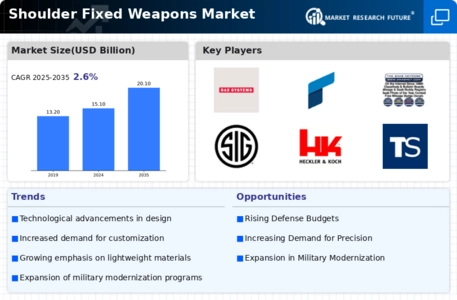Increased Defense Spending
The Shoulder Fixed Weapons Market is poised for growth as nations around the world are increasing their defense budgets. This trend is driven by rising security concerns and the need to modernize military capabilities. According to recent data, defense spending has seen a consistent rise, with many countries allocating significant portions of their budgets to upgrade their arsenals. This increase in funding is likely to result in higher procurement rates of shoulder-fixed weapons, as governments prioritize the acquisition of advanced systems. Additionally, the competitive landscape among nations may further fuel this demand, as countries strive to maintain or enhance their military readiness. Consequently, the industry is expected to benefit from this upward trajectory in defense expenditures.
Rising Demand for Personal Defense
The Shoulder Fixed Weapons Market is witnessing a growing demand for personal defense weapons among civilians. As concerns about personal safety and security rise, individuals are increasingly seeking reliable and effective means of self-defense. This trend is reflected in the rising sales of shoulder-fixed weapons designed for civilian use, which are often marketed for home defense and personal protection. Additionally, the regulatory environment is gradually becoming more favorable for civilian ownership of such weapons, further stimulating market growth. Manufacturers are responding to this demand by developing user-friendly designs that cater to non-military consumers. This shift indicates a diversification of the market, with potential implications for future product development and marketing strategies.
Geopolitical Tensions and Conflicts
The Shoulder Fixed Weapons Market is significantly influenced by ongoing geopolitical tensions and conflicts. As nations face threats from both state and non-state actors, the demand for effective military solutions, including shoulder-fixed weapons, is likely to rise. Recent conflicts have underscored the necessity for portable and versatile weapon systems that can be deployed rapidly in various combat scenarios. This situation suggests that military forces are increasingly investing in shoulder-fixed weapons to enhance their operational capabilities. Furthermore, the potential for escalated conflicts in volatile regions may drive further investments in these systems, indicating a robust market outlook. The industry appears well-positioned to respond to these evolving security dynamics.
Technological Advancements in Weaponry
The Shoulder Fixed Weapons Market is experiencing a notable transformation due to rapid technological advancements. Innovations in materials and design are enhancing the performance and effectiveness of shoulder-fixed weapons. For instance, the integration of lightweight composites and advanced targeting systems is improving accuracy and reducing the overall weight of these weapons. As a result, military forces are increasingly adopting these modernized systems, which are projected to account for a substantial share of the market. Furthermore, the development of smart weapons, which utilize artificial intelligence for enhanced targeting, is likely to drive demand. This trend suggests that the industry will continue to evolve, with manufacturers focusing on research and development to meet the changing needs of armed forces.
Emerging Markets and Defense Collaborations
The Shoulder Fixed Weapons Market is benefiting from the emergence of new markets and international defense collaborations. Countries that are developing their military capabilities are increasingly looking to procure advanced shoulder-fixed weapons to enhance their defense systems. This trend is particularly evident in regions where defense partnerships are being established, allowing for technology transfer and joint development initiatives. Such collaborations not only facilitate access to advanced weaponry but also promote local manufacturing capabilities. As a result, the market is likely to see an influx of new players and innovative products. This dynamic environment suggests that the industry will continue to expand, driven by both domestic and international demand for shoulder-fixed weapons.


















Leave a Comment